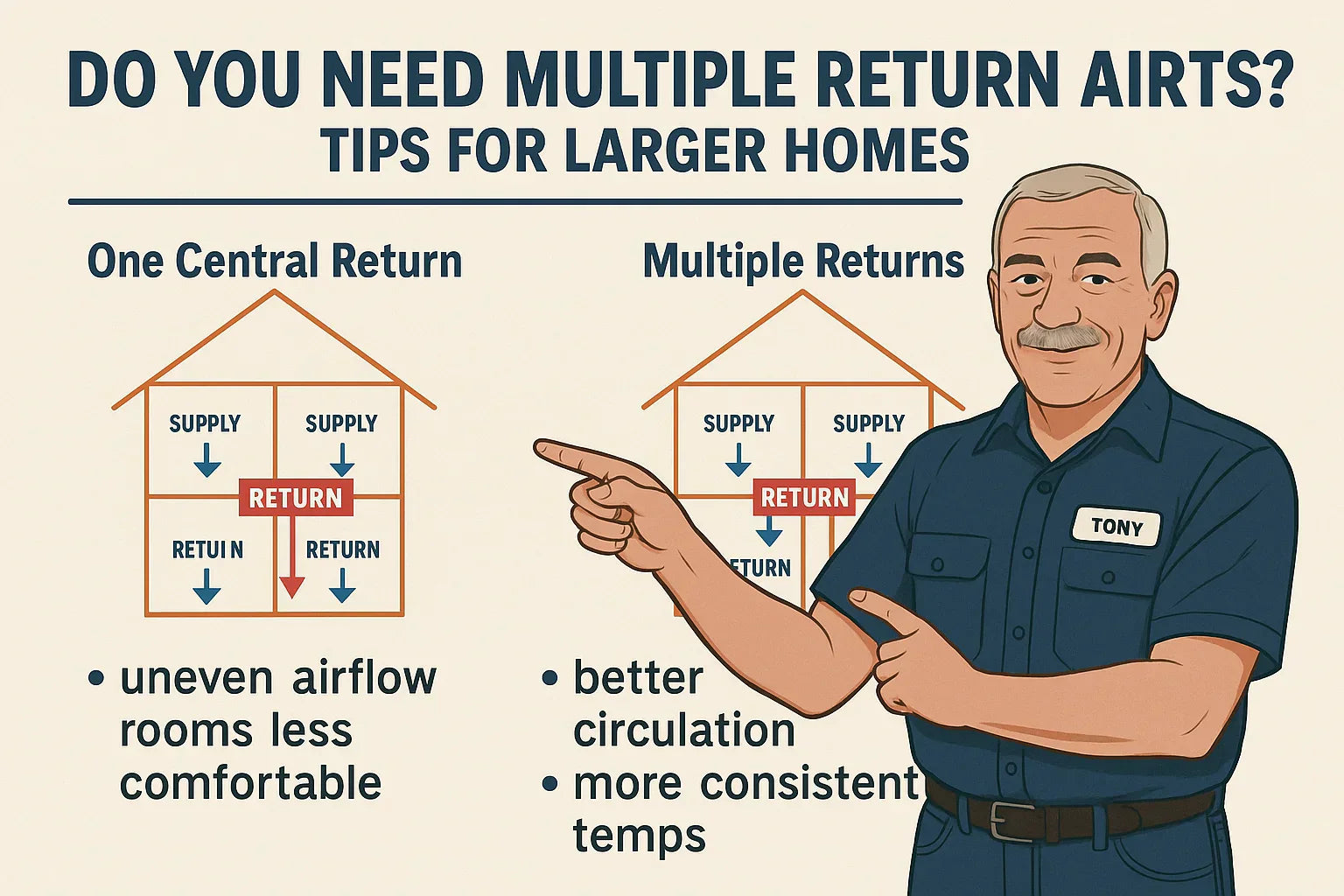🔧 What Return Air Ducts Actually Do
👨🔧 “Tony here. I always tell folks: your HVAC system doesn’t just blow air—it breathes. Supply ducts push conditioned air out, and return ducts pull the air back in. That balance is what keeps your home comfortable. If you only have one return in a big house, you’re asking your system to breathe through a straw.”
Southwark 811 Return Air Duct for 20x10-25x16 Sizes
Return ducts serve three major jobs:
-
Balance air pressure so conditioned air circulates evenly.
-
Filter out dust, pollen, and pollutants before air re-enters the system.
-
Maintain system efficiency by preventing strain on the blower motor.
📎 Trane explains why return vents are critical for efficiency and comfort.
🏘️ Why Larger Homes Need Special Attention
In small homes, a single central return often gets the job done. But in larger homes—especially two-story houses or open floorplans—the story changes.
Problems with one return in a large home:
-
Rooms farthest from the return feel stuffy or stale.
-
Upstairs may be too hot in summer and too cold in winter.
-
Pressure imbalance causes drafts, whistling, and wasted energy.
-
Longer run times = higher utility bills.
📎 Energy.gov confirms that duct design and placement are key for large homes.
👨🔧 “I’ve walked into big houses with a $10,000 HVAC system that couldn’t keep the upstairs comfortable. Why? They cheaped out on returns. A system is only as good as its airflow.”
🚪 Signs Your Home Might Need Multiple Returns
-
Uneven Comfort: Some rooms always feel hotter/colder.
-
Air Pressure Problems: Doors slam shut or whistle when the system kicks on.
-
Stale or Musty Odors: Weak return airflow means stagnant air.
-
Noisy Return Grille: A whistling grille = undersized or overworked return.
-
Long Run Times: System cycles longer but comfort doesn’t improve.
📎 HVAC.com explains poor return design is one of the top comfort killers.
📐 How Many Return Ducts Do You Really Need?
This depends on square footage, system size, and layout.
General Rules of Thumb:
-
1 square inch of return grille per square foot of living space.
-
Each ton of cooling = ~400 CFM (cubic feet per minute) of airflow.
-
Every supply needs a matching return.
Example:
-
2,400 sq ft two-story home
-
4-ton HVAC system (needs 1,600 CFM total airflow)
-
One 20x25 grille moves ~1,200 CFM = undersized
-
Add another 16x20 upstairs grille (~700 CFM) = balanced system
📎 Energy Vanguard breaks down airflow math for returns.
💨 The Science of Airflow Balance in Large Homes
Airflow balance is like a seesaw—supply and return must stay even.
-
Too much supply air (not enough return): Positive pressure forces air out through cracks → wasted energy + dust from outside creeping in.
-
Too much return air (not enough supply): Negative pressure pulls air from attics, basements, or crawlspaces → allergens, humidity, and even mold spores.
👨🔧 “I see a lot of houses where the HVAC is basically stealing air from the attic because returns are undersized. Folks wonder why their allergies are bad—it’s because they’re breathing insulation dust.”
📎 ASHRAE notes proper return design is crucial for IAQ and energy balance.
✅ Best Practices for Placement in Bigger Homes
-
Every floor needs at least one return.
-
Bedrooms benefit from their own returns, especially in homes with closed-door sleepers.
-
Hallways & living spaces should have large returns to cover common areas.
-
Avoid kitchens, bathrooms, and laundry rooms (humidity, odors, and grease).
Pro Layout Example:
-
1st Floor → Central hallway return + living room return
-
2nd Floor → Hallway return + master bedroom return
-
Optional → Returns in kid’s bedrooms for balance
💵 Cost of Adding Extra Return Air Ducts
Adding returns is not as expensive as replacing a whole HVAC system—and it often solves problems instantly.
Typical Costs:
-
Install new return grille + duct run: $500–$1,200 each
-
Adding multiple returns in large home: $2,000–$4,000
-
Duct sealing/insulation: $1,000–$2,000 (whole system)
👨🔧 “I tell my customers all the time—spend a grand on extra returns and you’ll get more comfort than upgrading to a $3,000 high-efficiency unit. Airflow is king.”
🚫 Common Mistakes Homeowners Make
-
Assuming one big central return is enough.
-
Using undersized grilles that restrict airflow.
-
Blocking returns with furniture, drapes, or rugs.
-
Installing returns in humidity-heavy rooms (bathrooms, kitchens).
-
Failing to seal duct seams, allowing attic/basement air in.
📎 Southern Living warns that blocked vents and poor return design hurt comfort.
🛠️ Tony’s Pro Tips for Larger Homes
-
Use sheet metal for main returns. Flex duct kinks too easily.
-
Go big on grilles. Oversizing grilles reduces noise and strain.
-
Filter at the return. Install return filter grilles for easier changes.
-
Check every 2–3 years for leaks, dirt, or blockages.
-
Consider zoning systems if you’ve got more than two stories.
📎 Wamboldt HVAC emphasizes that multiple returns improve IAQ and efficiency.
❓ FAQs About Multiple Return Ducts
Q: Do I need a return in every bedroom?
Not always, but in large homes it helps prevent stuffiness.
Q: Will bigger grilles fix my problem?
Sometimes, but placement matters as much as size.
Q: Is it bad to have too many returns?
Not really—oversizing is better than starving the system.
Q: How do I know if my returns are big enough?
Have a tech measure CFM and compare it to system tonnage.
📌 Final Word from Tony
👨🔧 “Here’s the bottom line: if your house is over 2,000 square feet and you’ve only got one lonely return grille, you’re short-changing your system. Bigger homes need multiple returns for balance, comfort, and air quality. Add them in the right spots, seal them up, and you’ll get a system that finally works with you—not against you.”
In the next topic we will know more about: How to Maintain and Clean Your Return Air Ducts







